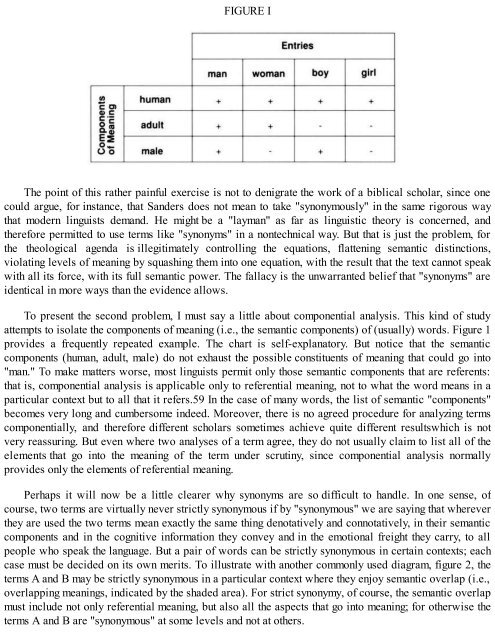Exegetical Fallacies - D. A. Carson
Exegetical Fallacies - D. A. Carson
Exegetical Fallacies - D. A. Carson
You also want an ePaper? Increase the reach of your titles
YUMPU automatically turns print PDFs into web optimized ePapers that Google loves.
FIGURE I<br />
The point of this rather painful exercise is not to denigrate the work of a biblical scholar, since one<br />
could argue, for instance, that Sanders does not mean to take "synonymously" in the same rigorous way<br />
that modern linguists demand. He might be a "layman" as far as linguistic theory is concerned, and<br />
therefore permitted to use terms like "synonyms" in a nontechnical way. But that is just the problem, for<br />
the theological agenda is illegitimately controlling the equations, flattening semantic distinctions,<br />
violating levels of meaning by squashing them into one equation, with the result that the text cannot speak<br />
with all its force, with its full semantic power. The fallacy is the unwarranted belief that "synonyms" are<br />
identical in more ways than the evidence allows.<br />
To present the second problem, I must say a little about componential analysis. This kind of study<br />
attempts to isolate the components of meaning (i.e., the semantic components) of (usually) words. Figure 1<br />
provides a frequently repeated example. The chart is self-explanatory. But notice that the semantic<br />
components (human, adult, male) do not exhaust the possible constituents of meaning that could go into<br />
"man." To make matters worse, most linguists permit only those semantic components that are referents:<br />
that is, componential analysis is applicable only to referential meaning, not to what the word means in a<br />
particular context but to all that it refers.59 In the case of many words, the list of semantic "components"<br />
becomes very long and cumbersome indeed. Moreover, there is no agreed procedure for analyzing terms<br />
componentially, and therefore different scholars sometimes achieve quite different resultswhich is not<br />
very reassuring. But even where two analyses of a term agree, they do not usually claim to list all of the<br />
elements that go into the meaning of the term under scrutiny, since componential analysis normally<br />
provides only the elements of referential meaning.<br />
Perhaps it will now be a little clearer why synonyms are so difficult to handle. In one sense, of<br />
course, two terms are virtually never strictly synonymous if by "synonymous" we are saying that wherever<br />
they are used the two terms mean exactly the same thing denotatively and connotatively, in their semantic<br />
components and in the cognitive information they convey and in the emotional freight they carry, to all<br />
people who speak the language. But a pair of words can be strictly synonymous in certain contexts; each<br />
case must be decided on its own merits. To illustrate with another commonly used diagram, figure 2, the<br />
terms A and B may be strictly synonymous in a particular context where they enjoy semantic overlap (i.e.,<br />
overlapping meanings, indicated by the shaded area). For strict synonymy, of course, the semantic overlap<br />
must include not only referential meaning, but also all the aspects that go into meaning; for otherwise the<br />
terms A and B are "synonymous" at some levels and not at others.



